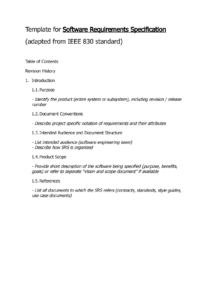In software development, detailed specifications are crucial for ensuring alignment between stakeholders and specifying the functional and non-functional requirements of a system. One key aspect of this is defining the hardware requirements, which describe the computing resources needed for the system to operate effectively.
To streamline this process, a hardware requirements specification template can be a valuable tool. It provides a standardized framework for capturing and organizing the necessary information, facilitating clear communication and reducing the risk of omissions or inconsistencies.
Understanding the Hardware Requirements Specification Template
A well-crafted hardware requirements specification template typically consists of several sections that cover various aspects of the system’s hardware needs. These sections may include:
System Overview: This section provides a high-level description of the system, including its purpose, scope, and key functionality.
Hardware Components: This section lists the specific hardware components required for the system to operate, such as processors, memory, storage, network interface cards, and peripheral devices.
Performance Requirements: This section specifies the minimum and desired performance levels for the system, including metrics such as processing speed, memory bandwidth, and storage capacity.
Scalability and Availability Requirements: This section outlines the system’s requirements for scalability and availability, addressing how it should handle increased load or the failure of specific components.
Environmental Requirements: This section specifies the environmental conditions within which the system must operate, including temperature ranges, humidity levels, and electromagnetic compatibility considerations.
Benefits of Using a Hardware Requirements Specification Template
Using a hardware requirements specification template offers numerous benefits for software development teams:
Improved Communication: A standardized template ensures consistency in capturing and communicating hardware requirements, facilitating clear understanding among stakeholders.
Reduced Risk: By providing a comprehensive and well-organized specification, the template helps identify and address potential issues early on, reducing the risk of costly rework.
Enhanced Quality: A well-defined hardware specification supports the design and implementation of a robust and reliable system that meets the intended performance and functional requirements.
Time and Cost Savings: The template streamlines the hardware requirements gathering process, saving time and reducing the overall project cost.
Vendor Selection: The specification template provides a clear basis for evaluating vendor proposals and selecting hardware that meets the system’s needs.
Conclusion
A hardware requirements specification template is an essential tool for ensuring a clear definition and communication of the hardware resources needed for a software system. By using a well-crafted template, development teams can improve collaboration, reduce risk, enhance system quality, save time and costs, and make informed vendor selection decisions.
Adopting a standardized template promotes consistency and completeness in documenting hardware requirements, contributing to successful software development projects.
